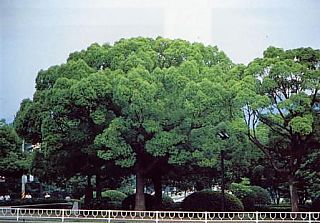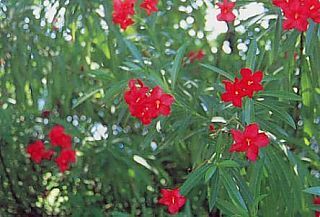City Tree (Camphor) and City Flower (Oleander)
Designation Goal
Our goal is to foster the spirit of city greening through designating a City Tree and City Flower from trees and flowers which are connected to the everyday lives of city residents and are well known as representative symbols of our city.
Selection Procedure and Results
In August 1973, it was decided to have city residents vote on a City Tree and City Flower in accordance with the designation goal listed above. However, as it was a little too open-ended to merely have residents vote for whatever tree or flower they thought suitable, the city decided to instead prepare a list of candidate trees and flowers for them to choose from.
Tree and flower candidates were chosen by the City Tree and Flower Selection Committee, made up of two City Council members, two academic experts, one media specialist, and three municipal employees for a total of eight. On September 29 of the same year, the committee settled on the following trees and flowers:
Trees
- Camphor (Cinnamonum camphora)
- Southern Magnolia (Magnolia grandiflora)
- Kurogane Holly (Ilex rotunda)
Flowers
- Cotton Rose Hibiscus (Hibiscus mutabilis)
- Canna (Canna generalis)
- Oleander (Nerium indicum)
Voting began on October 3 of the same year, using voting forms which were distributed with six different newspapers, as well as voting forms which were available at all municipal facilities. Votes were collected from October 3 to 27.
On October 29, the votes were tallied and with the most votes, the camphor tree and the oleander flower were chosen as the official City Tree and City Flower of Hiroshima City.
On November 3, the City Tree and Flower Designation Ceremony was held at Hana-no-Sei square in front of Chūō Park in Moto-machi, where the camphor tree and oleander flower were officially made our City Tree and Flower.
City Tree: Camphor (Cinnamonum camphora)
Before the war, giant trees of great age could be seen throughout the city, the massive camphor tree at the Kokutaiji Temple being one of the most well-known examples. These trees were a source of comfort for the residents of the city, but nearly all were lost in the August 6, 1945 bombing. The camphor trees that managed to survive quickly recovered, becoming a source of hope and inspiration for the citizens on the road to recovery. They remain a symbol of a Hiroshima reborn, an evergreen to paint the seasons.

City Flower: Oleander (Nerium indicum)
As the very first flower to bloom on the scorched earth of Hiroshima, where it was said that nothing would grow for 75 years, the oleander flower was a source of strength and hope for the residents of the city as they worked hard on recovery efforts. Blooming in the summertime, the oleander flowers reach their peak around the August 6 Peace Memorial Day, their beautiful blossoms reminding our citizens of a great many and profound feelings.

Inquiries about this page
Flowers and Greenery Policy Section, Landscape Division, Greenery Promotion Department, Urban Development Bureau
1-6-34 Kokutaiji-machi, Naka-ku, Hiroshima
Tel: 082-504-2396 / Fax: 082-504-2391
Mail: [email protected]
